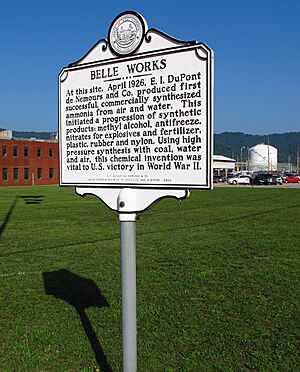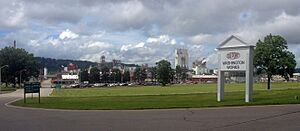DuPont facts for kids
 |
|
| Public | |
| Traded as | |
| ISIN | US26614N1028 |
| Industry | Chemicals |
| Predecessors | |
| Founded |
|
| Headquarters | Wilmington, Delaware, U.S. |
|
Area served
|
Global |
|
Key people
|
|
| Revenue | |
|
Operating income
|
|
| Total assets | |
| Total equity | |
|
Number of employees
|
24,000 (2024) |
DuPont de Nemours, Inc., often called DuPont, is a big American company that makes many different chemicals and materials. It was started in 1802 by a French-American chemist named Éleuthère Irénée du Pont.
The company played a big part in the growth of Delaware, a U.S. state. It first became known for making gunpowder. Over the years, DuPont created many important materials like neoprene, nylon, Teflon, and Kevlar. Its scientists also developed chemicals like Freon for refrigerators.
In 2015, DuPont and the Dow Chemical Company decided to join together. They formed a new company called DowDuPont in 2017. After about 18 months, DowDuPont split into three separate companies. One kept the Dow Chemical name, another was called Corteva (for farming products), and the third became the new DuPont, focusing on special products. Before this split, DowDuPont was the largest chemical company in the world based on sales. Today, DuPont's main office is still in Wilmington, Delaware.
Contents
History of DuPont
 |
|
| Public | |
| Traded as | NYSE: DD |
| Industry | Chemicals |
| Fate | Merged with Dow Chemical to form DowDuPont, which later split into three companies |
| Successor | Dow Chemical (Materials) DuPont (Specialty products) Corteva (Agricultural products) |
| Founded | July 1802 |
| Founder | Éleuthère Irénée du Pont |
| Defunct | August 31, 2017 |
| Headquarters | Wilmington, , |
|
Area served
|
90 countries |
| Products | |
| Subsidiaries |
Subsidiaries list
DuPont Chemical & Energy Operations DuPont Pioneer Danisco Solae DuPont Danisco |
Starting the Company (1802-1902)
DuPont was founded in 1802 by Éleuthère Irénée du Pont. He used money from France and brought gunpowder machines from there. He started the company at the Eleutherian Mills, near Wilmington, Delaware. Du Pont and his family had left France to escape problems there.
The company began by making gunpowder. Du Pont noticed that North America needed better gunpowder. The company grew fast. By the mid-1800s, it was the biggest supplier of gunpowder to the United States military. It supplied a lot of the powder used during the American Civil War. The Eleutherian Mills site is now a museum.
Growing Bigger (1902-1912)
DuPont kept growing and started making dynamite and smokeless powder. In 1902, the company's president, Eugene du Pont, passed away. The remaining owners sold the company to three of the founder's great-grandsons.
The company bought several smaller chemical companies. By 1912, this growth led to government review. Rules about fair competition meant they had to split off some parts of their explosives business. This led to the creation of the Hercules Powder Company and the Atlas Powder Company.
In 1910, DuPont published a brochure called "Farming with Dynamite." It showed how dynamite could help farmers remove tree stumps and other obstacles.
DuPont also set up two of the first industrial research labs in the U.S. Here, they began working on new materials like cellulose and lacquers.
Investing in Cars (1913-1919)
In 1914, Pierre S. du Pont invested in the new car industry. He bought shares in General Motors. The next year, he joined GM's board and later became its chairman. DuPont helped GM even more by buying $25 million worth of its stock.
By 1920, Pierre S. du Pont was the president of General Motors. Under his leadership, GM became the top car company in the world. However, in 1957, rules about fair competition meant DuPont had to sell its shares in General Motors.
New Discoveries (1920-1940)

In 1920, DuPont teamed up with a French company to make "artificial silk," also known as Rayon. This material was already around, but DuPont helped make it more common in the U.S. In 1924, "artificial silk" was officially named Rayon in the U.S.
In 1923, the two companies also started making Cellophane together. DuPont later bought out the French company's share in both ventures.
Throughout the 1920s, DuPont focused on materials science. They hired a scientist named Wallace Carothers in 1928. Carothers invented neoprene, which is a type of synthetic rubber. He also created the first polyester and, in 1935, nylon.
DuPont also started making synthetic ammonia in 1924.
In 1930, General Motors and DuPont created a company called Kinetic Chemicals to make Freon. Freon was used as a refrigerant in things like refrigerators.
A few years later, DuPont invented Teflon.
During World War II (1941-1945)
DuPont was one of the top companies in the U.S. for wartime production. As the inventor of nylon, DuPont helped make materials for parachutes, powder bags, and tires.
DuPont also played a big part in the Manhattan Project in 1943. They designed, built, and ran the Hanford plant in Hanford, Washington, which produced plutonium. In 1950, DuPont also agreed to build the Savannah River Plant in South Carolina to help create the hydrogen bomb.
New Materials for the Space Age (1950-1970)
After World War II, DuPont kept focusing on new materials. They developed Mylar, Dacron, Orlon, and Lycra in the 1950s. In the 1960s, they created Tyvek, Nomex, and Kevlar.
DuPont was very important in developing modern body armor. During World War II, DuPont's ballistic nylon was used to make flak jackets. With the invention of Kevlar in the 1960s, DuPont tested if it could stop a bullet. This research led to the bullet-resistant vests used by police and military today.
Changes and Sales (1981-1999)
In 1981, DuPont bought Conoco Inc., a large oil and gas company. This gave DuPont a steady supply of petroleum, which is needed to make many of its products. Seagram Company Ltd. became DuPont's biggest shareholder for a while. In 1995, DuPont bought back all the shares owned by Seagram.
In 1999, DuPont sold off Conoco. Conoco later joined with Phillips Petroleum Company. Also in 1999, DuPont bought the Pioneer Hi-Bred agricultural seed company.
Growth and New Focus (2000-2015)
DuPont was a very large company during this time, with billions in revenue. It had many research and development centers around the world. They invested a lot in new technologies for farming, cars, electronics, and more.
DuPont's agriculture division, DuPont Pioneer, made and sold hybrid seed and genetically modified seed. These seeds were designed to resist certain herbicides or insects.
In 2001, the company sold its pharmaceutical business. In 2004, it sold its textiles business, which included famous brands like Lycra and Dacron.
In 2010, DuPont Pioneer got approval to sell Plenish soybeans. These soybeans have a high amount of oleic acid, making them healthier and more stable for food and industrial uses.
In 2011, DuPont was the world's largest maker of titanium dioxide. This is a white pigment used in things like paper.
DuPont bought the Danish company Danisco in 2011. In 2012, DuPont took full ownership of Solae, a company that makes soy-based ingredients.
In 2013, DuPont sold its Performance Coatings business, which was renamed Axalta Coating Systems.
In 2015, DuPont spun off its Performance Chemicals business into a new company called The Chemours Company. This meant Chemours became responsible for cleaning up many former DuPont sites. After this, DuPont focused more on GMO seeds, materials for solar panels, and alternatives to fossil fuels.
Joining and Splitting Again (2015-Present)
On December 11, 2015, DuPont announced it would merge with Dow Chemical Company. The new company, DowDuPont, was worth an estimated $130 billion. The merger was completed on August 31, 2017.
After the merger, the leaders of DowDuPont decided to split the company into three independent, publicly traded companies:
- Corteva Agriscience: This company combines Dow and DuPont's seed and crop protection businesses.
- Dow Chemical Company: This company focuses on materials science.
- DuPont: This company kept the specialty products, including nutrition, industrial biosciences, safety, and electronics.
These splits happened in 2019. DuPont then started to create a new identity for itself.
In February 2020, Edward D. Breen returned as DuPont's CEO. Lori D. Koch became the Chief Financial Officer (CFO).
In November 2021, DuPont planned to buy Rogers Corporation, but the deal was canceled in November 2022 because Chinese regulators took too long to approve it.
In May 2024, DuPont announced it would split into three publicly traded companies again. It plans to separate its electronics and water businesses. Lori Koch became CEO on June 1, 2024, and Ed Breen became executive chairman. The split is expected to be finished in 18 to 24 months. However, in January 2025, DuPont decided to keep its water division within the company.
Where DuPont Operates
| 2010 | 949 |
| 2009 | 171 |
| 2008 | 992 |
| 2007 | 1,652 |
| 2006 | 1,947 |
| 2005 | 2,795 |
| 2004 | −714 |
| 2003 | −428 |
| 2002 | 1,227 |
| 2001 | 6,131 |

DuPont's main office and research center are in Wilmington, Delaware. The company has factories, research labs, and offices all over the world. Some major manufacturing sites include the Spruance plant near Richmond, Virginia, the Washington Works site in Washington, West Virginia, and plants in Axis, Alabama, and Houston, Texas. They also have locations in Belgium, China, and India.
Company Rules and Approvals
In 2017, the European Commission looked into the planned merger of DuPont and Dow Chemical. They wanted to make sure the merger would not reduce competition in areas like crop protection and seeds. The approval process took some time.
To get approval, the companies offered to sell off parts of their businesses. For example, DuPont sold some of its crop protection business. Dow also sold some of its chemical facilities.
The European Commission approved the merger in April 2017, with these conditions. China also approved the merger in May 2017.
Some people believed that by creating a single, independent U.S. agriculture company, Dow and DuPont could better compete with other large global companies. The merger was generally approved because it was not seen as having a big negative impact on the global seed markets.
Images for kids
See also
 In Spanish: DuPont Corporation para niños
In Spanish: DuPont Corporation para niños



